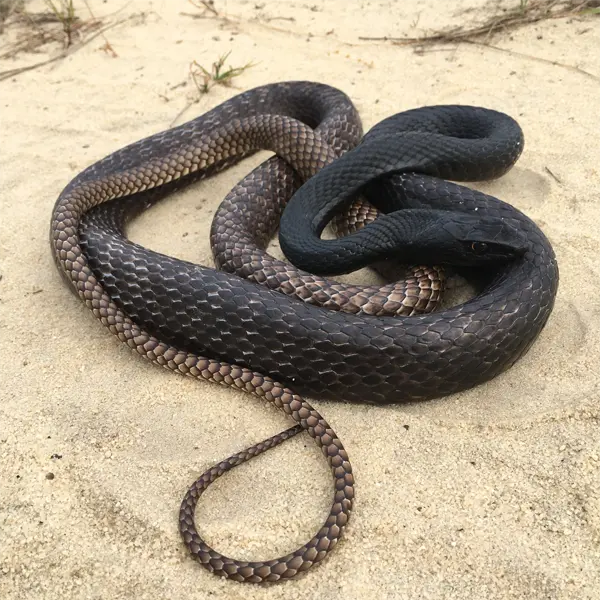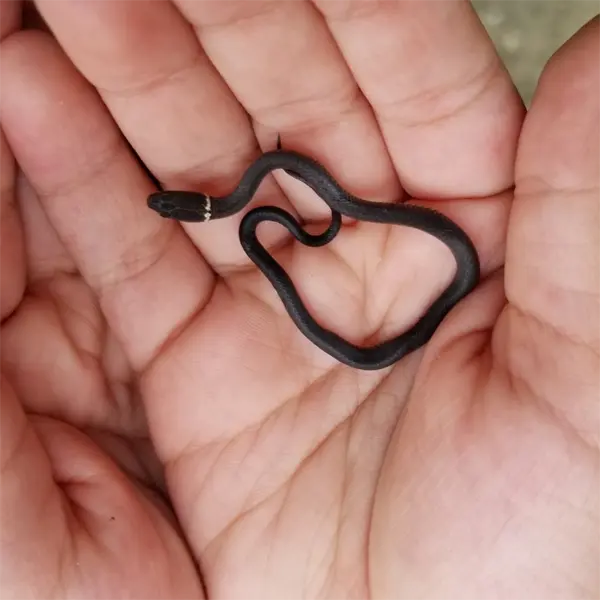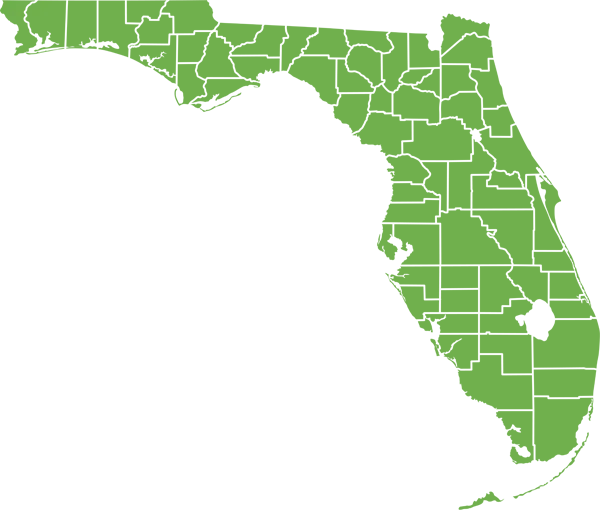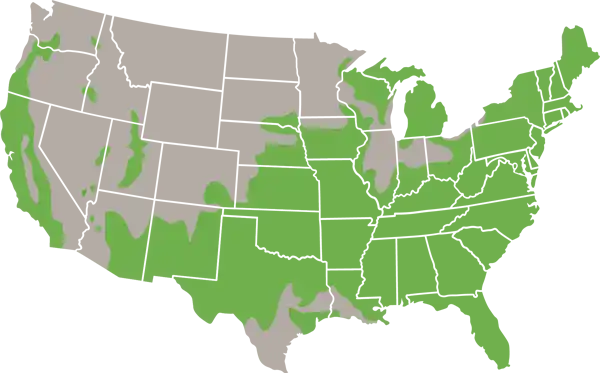Ring-necked Snake
- Scientific Name
- Diadophis punctatus
- Also Known As
- Ringneck Snake
- Range
- All of Florida
- Diet
- Salamanders, Worms, Slugs
- Life Expectancy
- 3 - 5 Years
Quick Links
The Ring-necked Snake in Central Florida
The ring-necked snake (Diadophis punctatus) is a small, harmless colubrid species found throughout central Florida. This nonvenomous snake is named for its distinctive yellow or orange neck band. Ring-necked snakes are secretive, nocturnal snakes that thrive in a variety of habitats.
This guide covers identification tips, biology, behavior, ideal habitat conditions, potential health risks, and prevention methods for ring-necked snakes in central Florida.
Ring-necked Snake Subspecies in the Area
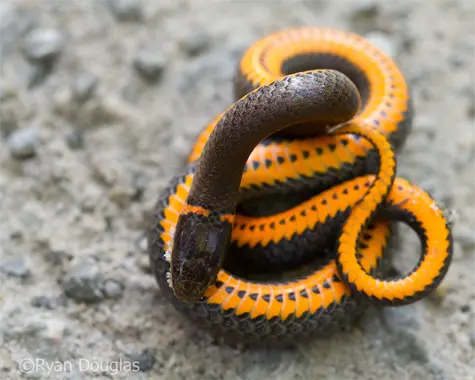
Photo 310401235 © luna101, CC BY-NC
Southern Ringneck Snake
The Southern ringneck snake (Diadophis punctatus ssp. punctatus) is a subspecies found throughout Florida. Genetic evidence shows they diverged from northern relatives long ago. They have distinct red or orange belly coloration unlike yellow bellies of other subspecies. Southern ringnecks also have divided anal plate scales and grow longer, up to 20 inches. Living in pine forests and scrub, their traits are likely habitat adaptations.
Habitat loss has greatly reduced their limited range. Calling them a distinct subspecies emphasizes the need for habitat protection. Preserving peninsula scrub is essential for the Southern ringneck.
Appearance and Identification
Ring-necked snakes can be identified by the following characteristics
Ring-necked snakes are often mistaken for baby coral snakes due to their colorful neck bands. Coral snakes have a black snout and bands of red, yellow, and black encircling the body. Other small snake species like ground snakes lack the vibrant neck ring of ring-necked snakes.
Maturation Rate
Ring-necked snakes mature rapidly. Males reach sexual maturity at 10-15 months old while females mature at 18-24 months old. The snakes breed soon after becoming reproductively active.
Habits and Behavior
Ring-necked snakes are nocturnal and generally secretive. They spend much of their time hiding under logs, leaf litter, rocks, bark, and other debris. When threatened, they may release a foul-smelling musk from their cloaca and curl up their tails to expose the bright ventral coloration as a warning signal.
Ring-necked snakes are non-venomous and harmless to humans. They may bite if handled roughly but cannot break human skin. Their primary defense is to release musk secretions, coil into a tight ball, and expose their bright belly to potential predators.
Reproduction and Lifespan
Ring-necked snakes mate from March to June in Florida. Females lay clutches of 3-7 eggs in June to August in rotting logs, compost piles, or underground. The eggs hatch in August and September. Hatchlings average 6-8 inches long.
Ring-necked snakes live for 3-4.5 years on average in the wild. The maximum lifespan may reach 7-10 years.
Ideal Habitat and Range
Central Florida’s humid, subtropical climate provides suitable habitat for ring-necked snakes. They thrive in areas with:
- Warm weather – Average temperatures between 70-80°F.
- Ample rainfall – 50+ inches annually especially in summer.
- Dense ground cover – Pine flatwoods, scrub, brush, palm hammocks.
- Moist microhabitats – Leaf litter, rotting logs, edge of wetlands.
Ring-necked snakes inhabit wooded suburban and urban areas in central Florida. They seek moist microclimates under debris in yards, parks, gardens, and landscaped commercial properties. Urbanization has expanded habitat via irrigated lawns, gardens, and detention ponds.
Diet and Feeding
Eastern coachwhips prey predominantly on small mammals, birds, lizards, snakes, and amphibians. Using chemosensory cues to hunt, they pursue prey actively during the day. Their diet includes:
- Small rodents – mice, rats, voles, squirrels
- Lizards – skinks, anoles, whiptails
- Snakes – eggs, juveniles, and smaller species
- Frogs, toads, salamanders
- Nestling birds, eggs
- Large insects – grasshoppers, beetles
Coachwhips use constriction to subdue prey before swallowing it whole head-first. They can go weeks between meals. Coachwhips sometimes raid rodent dens and consume eggs and juveniles, providing pest control services. They may also opportunistically eat carrion.
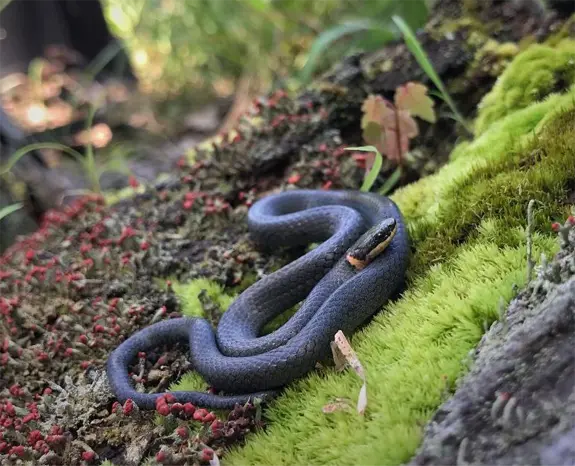
Photo 44769698 © bobbyfingers, CC BY-ND

Common Health Risks
Eastern coachwhips are nonvenomous and not aggressive toward humans. They can deliver a painful defensive bite if severely threatened but rarely bite unless handled. Minor wounds from a bite may become infected without care.
Some key points:
- Coachwhip saliva is not toxic or medically significant.
- The teeth are small and bites generally do not cause major injury. Disinfect thoroughly as with any animal bite.
- Coachwhips are not carriers of any infectious diseases transmittable to humans or domestic animals.
- They help control rodent and insect pest populations and are generally beneficial to suburban environments.
- Coachwhips should not be harmed or killed as they are protected native wildlife species in Florida.
Preventing Eastern Coachwhip Encounters
To discourage coachwhips, keep yards free of heavy vegetation and brush piles. Closing openings in foundations, vents, and garages prevents access. Glue traps along building perimeters safely catch small snakes.
Remove outdoor food sources like pet bowls and fallen fruit to avoid attracting prey. Coachwhip-proof fencing provides a physical barrier to keep snakes out of gardens and play areas. Teach children to recognize coachwhips and not approach them.
Many coachwhip encounters are benign. If one is spotted on your property, allow it to move away undisturbed. Never attempt to kill or capture a coachwhip yourself – always call a professional wildlife removal expert for humane removal assistance.
Eastern Coachwhips in Central Florida – Conclusion
Eastern coachwhips are quick, common snakes that frequent open habitats in central Florida. They are an important part of the local ecosystem and avoid interactions with humans. With proper identification, exclusion techniques, and removal of habitat attractants, coachwhips can be deterred from taking up residence near homes.
Educational outreach also promotes tolerance and sensible precautions around these harmless native snakes.



